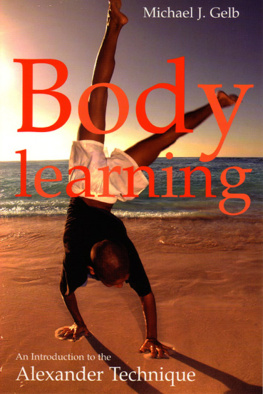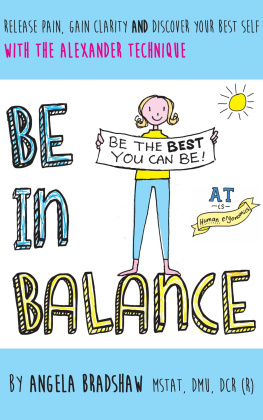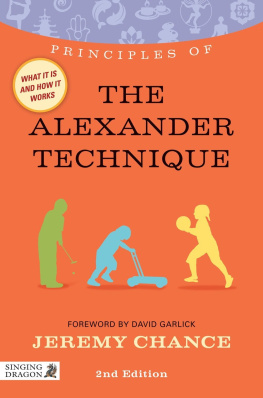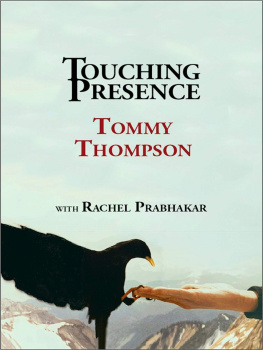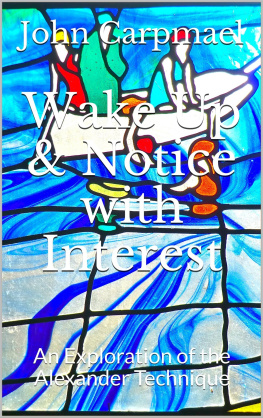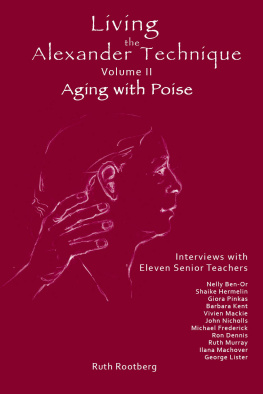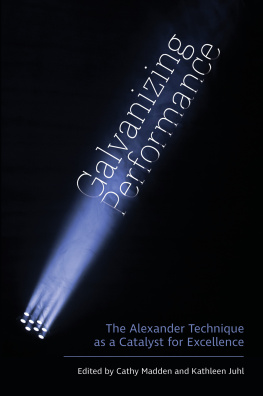The Alexander Technique for Musicians
The Alexander Technique for Musicians
JUDITH KLEINMAN AND PETER BUCKOKE

CONTENTS
We would like to thank all our Alexander teachers, colleagues and friends who have helped us on the way to writing this book and the Musician/Alexander teachers from the training schools, who have contributed some of the Student quotes.
A very large thank you must go to Paul Chapman and Lori Schiff for their thorough reading of our script and their extremely useful suggestions of how to improve our book.
The diagrams are the excellent work of David Ashby.
The photo of Ruairi working with children (: Teacherpupil relationships), on the RCM outreach programme, was provided by Sheila Burnett.
Thanks go to Michael Deason-Barrow, Head of the Tonalis Institute, for letting us use his description of the Roles of the Larynx.
The two (video) images of the Schubert Ensemble were provided by Rob Hardcastle.
Our two sons
The photos are mostly the work of Abe who not only took the photos but also made the multi-image plates that give the sense of movement that is vital in this work. Harry gave us advice on how to organize and present the script. Harry and Abe are both in several of the photos. We would like to thank them both for their enthusiasm and support throughout the process of writing this book.
RCM
We are very grateful to the staff at the Royal College of Music, who have supported us through the development of the Alexander courses over the past 20 years. Special thanks go to Dr Elisabeth Cook (Head of Academic Development and Undergraduate Programmes) who has been with us for every step of the journey. Many thanks also go to Dr Amanda Glauert (Director of Programmes and Research) for her enthusiastic support and the quote about her personal experience of the Technique. Thanks also to David Harpham (Registry Officer) who has given us a taste of his personal experience of the Technique to include in the book.
The biggest debt of gratitude goes to the students at the Royal College of Music. We have observed their progress over the years and developed courses and ways of teaching from the interactive experience of sharing the Alexander Technique with these talented and highly intelligent musicians. Particular thanks go to the students who have given us permission to quote them and use photos of them in our book.
Since the 1950s, the Royal College of Music has been leading the music world in the use of the Alexander Technique in the training of the music students from countries throughout the globe. The Technique is a facilitator in the learning process. The musicians job is a craft that requires excellent coordination and an art that requires creativity and spontaneity. These aspects of performance are addressed with clear and practical guidance in The Alexander Technique for Musicians . The Alexander department at the RCM collaborates with our Centre for Performing Science on research and development. This book is evidence of over 20 years of research by our Alexander teachers, looking at how to best demonstrate and explain the Technique to musicians.
This book has been written with the performing musician in mind. It sets out a very clear explanation of the basics of the Alexander Technique and makes connections that will be useful for players of all instruments. There are photos of many College students that have taken part in Alexander courses and quotes from students that give a sense of just how useful the technique can be for aspiring musicians.
The authors, Judith Kleinman and Peter Buckoke, have the advantage of being highly accomplished and successful performing musicians, working in the London music scene. They have decades of experience teaching the Alexander Technique to musicians at the RCM. Many of their students have taken the technique deeply into their instrumental or vocal technique as well as their approach to performance. It is often our alumni that developed a keen interest in the Alexander Technique that are making the most impressive strides on the professional concert platforms and performing at the highest level in international competitions.
I have every confidence this will become a standard work that will be considered essential reading by all musicians, not only students, who are interested in exploring the potential of the Alexander Technique in relation to practice and performance.
Professor Colin Lawson
Director of the Royal College of Music, London

You could ask why humans might use the Alexander Technique in relation to any activity. One way of looking at this is to notice that some people find it easy to excel in their chosen field without any knowledge of the Alexander Technique. In fact, there are many musicians who are superbly coordinated without having learnt the Technique, however the majority of musicians do not have their best coordination available to them all of the time. It is quite often the case that a musician will have experienced moments of brilliance that convince them that they can play better than they do some or most of the time. Those glimpses, of achieving something like their potential, keep them practising hour after hour in the search of reliable coordination in their playing in general and performances in particular. Musicians are keen to practice and are expecting to learn by doing so. The Alexander Technique helps you to learn how to learn.
The technique is based on principles that help you to establish reliable coordination in your life and music making, so you are more likely to be able to do what you want to do in the way that you choose.
Highly trained athletes
Musicians have to train in a similar way to Olympic athletes. We may not need the heart and lung development of some athletes but we have to train various groups of muscles to even greater fitness and finesse than many sportsmen and women. We devote thousands of hours to developing our skills and we can easily feel under pressure when performing, just like athletes.
Talent versus skill
There is a generally held belief that talent makes the difference between just being able to learn the sport or the instrument and reaching the higher levels of performance. Talent is all about doing what is required at the given moment; some musicians have those skills in place intuitively. The Alexander Technique helps you develop the way the mind and body connect, communicate and function in all activities. You could say, it develops your talent by working on the skills that the talented have left in place, because they have not interfered with their coordination.
Modern life
Modern daily life includes sitting in front of computers, using the mobile, watching the TV, all of which can find us disengaging from our body and thinking only of the content on the screen in front of us life has become more sedentary. We may think of relaxation in terms of collapsing on the sofa on the other hand, when we come to play our instrument we have the idea of sitting or standing up straight (neither of them ideal). Alexander Technique helps us realize there is a connection between our Use in daily life and our music making.
Comfort and discomfort
The lifting, carrying and playing of a musical instrument often involves adopting challenging positions and movements. We might have to sit on an unsuitable chair for 6 hours or more in a day in a cramped space. We might have to travel for hours squeezed into an economy airline seat and then have to perform. The player moves to get a sound from the instrument and the movements can be comfortable or uncomfortable. If the early stages of learning a new instrument include discomfort, a critical situation has been reached. If at that point the musician decides that the discomfort is not acceptable and seeks a solution, the chances are that the learning will go on rapidly in a good direction. If the student musician puts up with discomfort or pain, the journey ahead will be going in the wrong direction. The unfortunate problem, or human challenge, is that we can easily override the discomfort on a tide of enthusiasm for the music or a passionate desire to play the instrument. Some musicians are so keen to play they screen out their sense of quality of movement that might avoid the discomfort in the first place.
Next page

